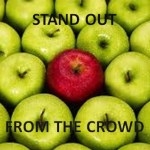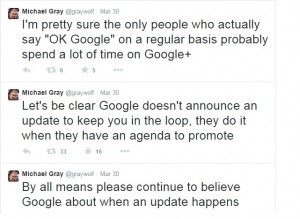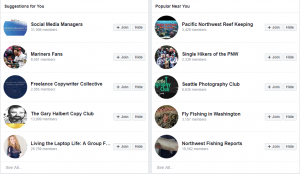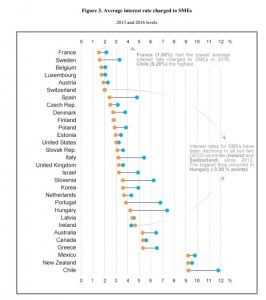— February 21, 2018
 Research tells us that in order to become a leader in your field, you need to demonstrate your business differentiators, to show how your company is different than your competitors.
Research tells us that in order to become a leader in your field, you need to demonstrate your business differentiators, to show how your company is different than your competitors.
And this is sound advice.
But, when you look at the websites of almost all B2B companies in any discipline, they all look pretty much alike, especially in what they say.
And of course, the competition, in our Internet world, could be anywhere, and many times not even companies we think are direct competitors.
Some Classic Examples of “NO” Differentiation
A company called Messages that Matter put out a description of B2B companies in the Business Intelligence market that showed how they all seem to embrace “me too” marketing; they say exactly what their competitors are saying.
Two examples;
1. These companies positioning statement is that they offer “insight” on how to grow your business – Qlik, Alteryx, Panorama, Microsoft, Oracle.
2. These companies; SAS, Tibco, Microstrategy state that they help companies make “better, faster, more informed, innovative decisions”.
Talk about banal business differentiators! Some of these companies are well-known, and yet they don’t actually have “differentiators”.
Which one would you choose to do business with?
What if your company competes directly or indirectly with any of these companies? Does your company give the same “business differentiators”?
How to Differentiate
There are two things you need to show your difference from your competitors.
1. You need a positioning statement that delivers a big benefit to your clients and potential clients.
2. You need to name your differentiators, with the benefit each of them delivers.
Here is how my company is different.
My company’s positioning statement is Helping Clients Increase Revenue 25% to 100% Every Year.
Possibly, there are other companies out there that have a similar positioning statement.
However, I have developed a number of processes and systems over my 40+ years as a B2B salesman, business owner, and coach, that are very different, and I believe no one else has.
How can I say that?
Because I have not seen anyone else talk about anything close to these processes and systems.
Also, all of my clients rave about how good these systems and processes are for generating new business for them.
But why should you care about my business differentiators?
Here’s why.
If you want to grow your B2B business faster and more effectively, and therefore with greater revenue, I can help you do that by implementing my systems and processes into your day-to-day sales and marketing.
It’s a combination of sales and marketing strategies and techniques, as well as client renewal and collaboration that will give you all of the tools you need, to take your company to the next level and beyond, in revenue generation.
If you sell and market by understanding your clients, and their life-time value, as well as implementing my systems and processes, you will grow much faster and easier than ever before.
So what are these “magical” systems and processes I have developed.
The CEB talks about using collaboration in order to work better with your client’s and prospect’s executives. But they don’t tell you how to do it.
Collaborate with your clients’ executives using my differentiators.
I always encourage my clients to start by understanding your current clients first, by utilizing these systems and processes.
Once you understand what, how and why your current clients bought, then you can start marketing and selling to similar companies, which will make your marketing and selling much easier and faster.
And once you do understand what, how and why your current clients bought, you can start selling them more also, because they trust your company, and you will also get to know what else they need to succeed.
My Business Differentiators & Benefits
Here are a few of my systems and processes that I build into my clients’ daily routine so they can get that 25% to 100% revenue gain every year;
1. The 7 Factors of B2B Sales & Marketing Success – the complete system for how to become an expert in B2B Sales & Marketing.
2. The GAIM Plan for interviewing and qualifying client executives in their language to see if their company is worthwhile pursuing for business.
3. Issue Decomposition, to show your clients’ executives how your products and services solve their issues, and how they fit into their goals and growth plans.
4. Point of View (POV) for both Industry and Client/prospect – research and analytics to learn everything you can about potential clients.
5. Relationship Ladder & Funnel Velocity – shows you a systematic method for developing relationships at every level, in order to have a client for life.
6. In-depth client Interviews. My interview questions allow you to completely understand why and how your clients bought, and how to make them clients for life.
7. Role-plays with salespeople, marketers and executives. Everyone needs to practice to become excellent at their craft. These role plays allow everyone with client contact to practice becoming excellent at their craft.
8. Facilitate planning sessions for clients. This allows you to completely understand what you clients are going to be doing in the coming year, and therefore prepare how you can help them achieve their goals.
These are proprietary systems, methodologies and processes, so I don’t put a lot of information about them on my website.
Plus, as I’m sure you know, it is much easier to talk to someone during an explanation so you can receive a real in-depth idea of how they work, and how they will help you and your company.
However, I do have a thorough explanation of my program, The 7 Factors of B2B Sales & Marketing Success Program on my site. Click the link to see my 7 Factors program.
Business & Finance Articles on Business 2 Community
(35)
Report Post







